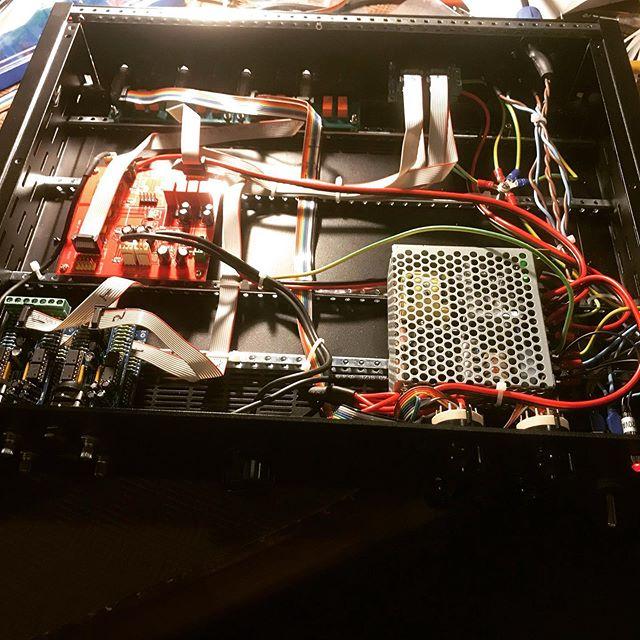Academy Dashboard › Forum › Studio › DIY › My monitor controller
Tagged: DIY, Monitor Controller
- This topic has 6 replies, 3 voices, and was last updated 3 years ago by
 Kevan Atkins.
Kevan Atkins.
-
AuthorPosts
-
July 13, 2020 at 2:14 am #77827
 Kevan AtkinsParticipant
Kevan AtkinsParticipantHey all,
New to PLAP academy. Having a poke around the forums to see what's happening. Thought I'd share a little project I worked on recently.
Since lockdown I've really been focusing on setting up my home studio space and make it nice. One of the big to do list items for a long time was sorting out a monitor controller. I found most of the options on the market were either way overpriced for what they did or were very poorly made. I had a particularly bad experience with a Presonus, which sent +14dBU 50Hz AC signal out to my Focals, which I came home to when I'd just nipped around the corner to the shops. Turns out the cheap, shitty, mains filter caps were bulging, which ended up introducing a lot of AC into the audio path. I'm amazed the Focals survived, since they were driven to almost full excursion for the best part of 10 minutes. They got real hot too. It was only supposed to be a temporary stopgap anyway, but I sure didn't anticipate that horror show. I only had the damn thing for a week... That prompted me to expedite the build on this monitor controller.
Currently 2 stereo ins driving 2 sets of monitors but I have IO boards to expand it to 4 ins and 4 outs. It can switch sources, speakers, stereo/L+R/L-R. It also has provisions for talkback if I want to add that later on. I used some boards designed by my friend of mine, who's former designer at Sebatron. Based on a Baxandall active volume control circuit. All the switching happens by relays on the main and IO boards, so it's super configurable. It's just a matter of sending 5V to the right relays to make it do what you want it to do.
It also features 4 JLM headphone amps that operate independently of the monitor controller, so it serves both those purposes for my little home studio. Finally, my favourite feature is that it has a powercon out that goes via main switch, so when I power the unit down, the monitors also power off, saving me have to dick around with reaching behind the monitors to turn them on or off or use those remote control switches. There is work to be done on DC distribution, but I’ve got something functional (hence why that section is still a bit untidy) until I get parts to make a power filter. Also got front panel artwork to do and a giant, obnoxious volume knob to order. But I’m pretty chuffed with the result. It's very transparent and quiet and has exactly the features I need for my little space.
 July 22, 2020 at 2:15 am #78423
July 22, 2020 at 2:15 am #78423 Edgar Duran-RamirezParticipant
Edgar Duran-RamirezParticipantHello,
it looks nice. But what is a monitor controller exactly for?
It's an isolation device to ensure that what we are hearing is only what it comes from our mix without sporeous signals?
RegardsEdgar
July 22, 2020 at 9:19 am #78439 Magnus FredholmParticipant
Magnus FredholmParticipantNice one Kevan, I am looking at some sort of monitor controller too, but possibly going passive, and I am i n no way capabe of building my own. Will stay clear of Presonus for that though, thanks for the heads up.
July 22, 2020 at 4:54 pm #78467 Kevan AtkinsParticipant
Kevan AtkinsParticipantHey Edgar. To answer your question, the function of a monitor controller is very much the same as the monitoring section of a studio console. Except nowadays studios tend not to have consoles anymore, so a separate monitor controller is required to fulfil that function. The most basic monitor controller will give you control over the volume of your monitors and put it at your fingertips. That alone has some advantages over, for instance, a digital volume control such as in RME's TotalMix or the master fader in your DAW, which effectively ends up downsampling the audio as you get to lower volumes.
Other features monitor controllers can have are mute, dim (bumps the volume of the monitors down by a fixed amount if you need to talk), talkback (for communicating with talent in the live room), output switching (switching between different speakers, in my case a pair of Focal Solo 6 BE and NS10s), source switching, mono (L+R), difference (L-R), solo L, solo R. Monitor controllers can get pretty complex and expensive. I decided to go the DIY route and build my own using a very modular design approach, so it can grow as my needs do.
July 22, 2020 at 5:32 pm #78469 Kevan AtkinsParticipant
Kevan AtkinsParticipantHey Magnus,
If you're going the passive route, they're super easy to build. Five components will get you a passive volume control circuit: four 4k7 resistors and a 10K log potentiometer. Add in a few rotary switches for monitor selection/mute/mono/diff/etc and some XLR connectors and put it all in a box and you've got yourself a monitor controller. The caveat with a passive design over an active design is that changing volume does affect the impedance that the monitor or amplifier sees, which, depending on your amp or monitor, can affect the frequency response at low levels, especially with longer cable runs, hence why I went with an active design.
https://www.audiotechnology.com/tutorials/on-the-bench-diy-monitor-controller
If you're really not comfortable with that though, there are plenty of options for passive, just be weary of the crazy price gouging that goes on with studio gear. Feel free to reach out if you need any help.
July 24, 2020 at 12:02 am #78541 Magnus FredholmParticipant
Magnus FredholmParticipantHey Kevan
While I have no real understanding of electronics, I am confident I can build that, with switches too:)
Thanks for the link, I'll holler if I get stuck.July 24, 2020 at 12:11 am #78546 Kevan AtkinsParticipant
Kevan AtkinsParticipantNo worries, Magnus. Best of luck with it. It's very satisfying building your own gear. You may become addicted and decide to learn more. Certainly saves a packet.
-
AuthorPosts
- You must be logged in to reply to this topic.

